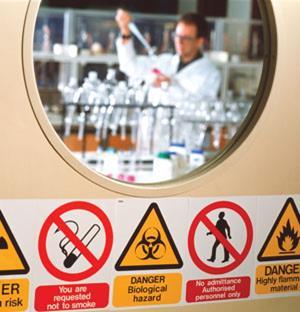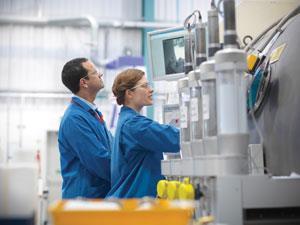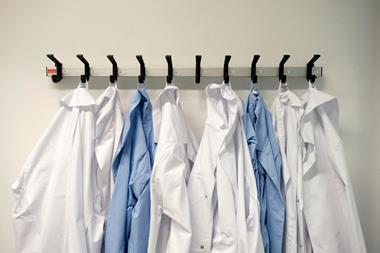Just how safe is working in a laboratory? Jon Evans discovers that it depends on where you are

In a 2012 survey of safety in US academic laboratories commissioned by the University of California Center for Laboratory Safety, 86% of around 2400 researchers who responded said they believed their laboratories were safe places to work. Now, that all sounds fairly positive, but dig a bit further into the figures and the picture looks less rosy.
For a start, senior researchers, who are responsible for ensuring laboratory safety, tend to be more confident about the safety of their laboratories than junior researchers, who actually spend most time in the laboratory. While 94% of senior researchers felt that appropriate safety measures were in place in their laboratories, only 69% of junior researchers agreed.
Furthermore, while most academic researchers thought their laboratories were safe places to work, they often engaged in unsafe practices. For example, around 80% of researchers reported that people worked in their laboratory alone at least once a week, a highly risky practice. And 54% reported that they sometimes didn’t wear a lab coat.
Similarly, 40% of the researchers claimed not to have received safety training on specific agents or hazards. This perhaps explains why chemists were less confident about safety in their laboratories than researchers in other fields. Around 60% of chemistry researchers thought that safety in their laboratories could be improved, compared to an average over all the researchers of 50%.
Serious accidents, such as chemical burns and chemical inhalation, also seem to occur reasonably frequently, with 30% of researchers aware of at least one ‘major’ injury occurring in a laboratory they were working in, serious enough to require attention from a medical professional. All in all, the survey paints a picture of academic researchers assuming their laboratories are safer than they actually are, paying lip-service to the concept of safety without actually backing it up in practice.
Improvements through tragedy

This is in stark contrast to industrial laboratories, which are generally held to be much safer. In a letter to Chemical & Engineering News in 2013, three executives from Dow, DuPont and Corning claimed that statistics from the US Occupational Safety & Health Administration (OSHA) showed that researchers are 11 times more likely to be hurt in academic laboratories than industrial ones. They further claimed that many companies spend weeks conducting remedial safety training before new hires from academia are allowed to work in their laboratories.
But according to Harry Elston of Midwest Chemical Safety, the picture in academia isn’t completely bleak. ‘There are academic research facilities on both ends of the safety spectrum: those with a poor safety culture and those with a rich safety culture. Likewise, there are institutions that are in transition after recognising they need improvement and they are somewhere between the two extremes.’
In the past few years, safety in academic laboratories has begun to move up the list of priorities. Not only are organisations such as the Royal Society of Chemistry (RSC), the American Chemical Society (ACS) and the US National Research Council (NRC) producing guidelines and reports on laboratory safety, but many US universities are implementing a raft of new safety measures in their laboratories. Unfortunately, the trigger for these developments was a couple of serious accidents that recently occurred in US chemistry laboratories.

The first occurred in 2008 in the laboratory of Patrick Harran, a chemist at the University of California, Los Angeles (UCLA), where research assistant Sheharbano Sangji was seriously burned while working with t-butyl lithium, which ignites on contact with air. She subsequently died from her injuries. Sangji was working on her own in the laboratory and was not wearing protective clothing.
The California division of OSHA concluded that the accident was caused by inadequate training, resulting in criminal charges being brought against UCLA and Harran. UCLA settled its charges in July 2012. This settlement required the university to accept responsibility for the conditions in Harran’s laboratory and to adopt the safety management model prevalent in industrial laboratories, where senior executives have a legal responsibility for ensuring laboratory safety. Harran’s trial is still ongoing.
UCLA also agreed to maintain a comprehensive laboratory safety programme that meets specific, stipulated safety standards. This will be monitored by a court-appointed official with the authority to impose fines on the university of up to $500,000 for noncompliance. Even before the settlement, UCLA had overhauled its safety practices and established the Center for Laboratory Safety to develop and disseminate safety training programmes and best practice.
The second accident occurred in 2010 at Texas Tech University in Lubbock, when graduate researcher Preston Brown was preparing a novel explosive material, a nickel hydrazine perchlorate derivative, in the laboratory of chemist Louisa Hope-Weeks. While breaking up clumps of this material with a pestle, it exploded; Brown lost three fingers, suffered burns to his face and hands, and damaged an eye.
This incident was subsequently investigated by the US Chemical Safety and Hazard Investigation Board (CSB), which released a report in October 2011 that identified a number of safety failings at Texas Tech. The report went beyond this single incident, however, to identify a further 120 incidents that had occurred in academic laboratories since 2001, including the death of Sangji at UCLA. This led the CSB to declare that it ‘is greatly concerned about the frequency of academic laboratory incidents in the US’.
Elston thinks it was not necessarily the accidents themselves that have changed people’s attitudes. ‘What got the attention of the academic research community were the felony manslaughter charges against Harran and the University of California Board of Regents. To my knowledge, the UCLA incident was the first time where an academic employer was held accountable for a research fatality,’ he says. ‘That act by the Los Angeles District Attorney resonated throughout the country and essentially put academic researchers on notice that they are going to be held to the same occupational standards as their industrial colleagues.’
Recommendations and resources
The CSB warned that these kind of failings are likely widespread throughout academic laboratories, saying it was ‘confident that a number of issues raised by this incident are relevant to academia as a whole’. For example, it thought that hazard evaluation guidance was not just lacking at Texas Tech, but across academic laboratories in general. It was also concerned that senior researchers heading academic laboratories tend to operate fairly autonomously without much oversight, often considering safety inspections to be unwarranted intrusions that hamper their research activities.

A major cause of these general safety failings, according to the CSB, is that while a large number of references, standards and guidelines have been developed for hazard evaluation in industrial laboratories, equivalent guidelines for academic laboratories don’t exist. Unfortunately, industrial guidelines can’t just be applied to academic laboratories, because the two types of laboratories conduct very different research.
‘Universities involved in the chemical sciences have a working environment that can be different to that found in industry,’ explains Moray Stark, chemistry safety officer at the University of York, UK, and chair of the University Chemical Safety Forum, a UK discussion group on chemical health and safety in higher education. ‘One way being that the more research-intensive universities can carry out work on an exceedingly wide range of topics, often in very novel fields of study, whereas most industrial companies, even those heavily into research, tend to work in a comparatively narrow field of chemistry.’
In its report, the CSB advised that universities should ensure their laboratory safety management plans address all possible safety hazards, including physical hazards, and keep a record of previous incidents and near-misses in order to identify any trends. They should also ensure that those responsible for inspecting laboratory safety report to someone with the authority to implement proposed safety improvements and impose sanctions on senior researchers who flout safety guidelines.

Texas Tech has already implemented many of these recommendations, including altering its organisational structure so that its environmental, health and safety director, who is responsible for laboratory safety, reports to the vice president for research rather than the vice president for administration and finance. Other universities are now beginning to follow suit, spurred both by the CSB’s report and an associated video it produced discussing the lessons that need to be learnt from several recent incidents, including those at Texas Tech and UCLA.
To provide assistance to universities, the CSB also recommended that the ACS develop the kind of good practice guidance for evaluating and controlling hazards in academic laboratories that already exists for industrial laboratories. It also suggested the need for a larger, more comprehensive study on academic laboratory safety.
The ACS unveiled its guidance in September 2013, in the form of a report entitled Identifying and Evaluating Hazards in Research Laboratories. Meanwhile, in March 2013 the NRC began just the kind of comprehensive study recommended by the CSB, with a project investigating laboratory safety in chemical research in non-industrial settings. The NRC plans to publish its findings in summer 2014.
Industry is also lending a hand. In March 2013, Dow launched the Lab Safety Academy, a web-based resource comprising videos, guidelines and worksheets to help promote safe practices in academic laboratories. Part of Dow’s rationale for setting up the academy is that it is increasingly funding research in academic laboratories and wanted to ensure that these were as safe as its own internal ones.
Elston, who is editor-in-chief of the Journal of Chemical Health & Safety stresses that lab culture is what matters. ‘Reliance on OSHA or any other regulatory body will not drive cultural change. Institutions must take a hard look at their own safety culture and recognise where change is necessary and proactively make those changes to provide a safe research environment.’
Across the pond
Similar safety initiatives are also taking place in the UK, again partly spurred by the recent incidents in the US. ‘That has a knock-on effect here, because details of those accidents were published in Chemistry World, so people will be asking if that could happen here,’ says Ian Wrightson, chair of the RSC’s Environment Health & Safety Committee’s (EHSC) Notes Group.
Institutions must take a hard look at their own safety culture
Harry Elston
The need is slightly less pressing in the UK, though, because academic laboratories are already covered by the Control of Substances Hazardous to Health (Coshh) regulations, which enshrine hazard evaluation and control. But there is no room for complacency, as an explosion in a chemistry laboratory at the University of Liverpool in 2009 makes clear.
One such initiative is a new online series of laboratory health and safety modules for academic researchers, developed by the RSC’s EHSC Notes Group. The first four modules were recently launched, focusing on topics such as Coshh and chemical safety, with five more due to appear in the next couple of months.
At the moment, these modules are aimed at UK researchers, but the intention is for them to be applicable to overseas researchers as well. ‘We will continue to develop and expand this project and we want to internationalise it as part of the expansion, so we’ll take out any specific references to UK legislation,’ says Wrightson.
Chemistry laboratories may usually be interesting, if occasionally slightly unpleasant, places to work, but there is no reason why they shouldn’t always be safe.
Jon Evans is a science writer based in Bosham, UK












No comments yet